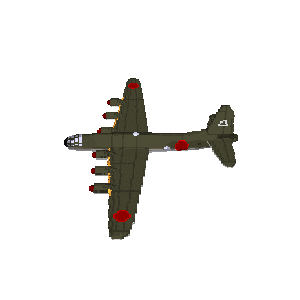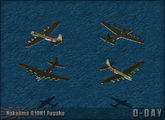Difference between revisions of "Nakajima G10N1 Fugaku"
From D-day: wiki
m |
|||
| (4 intermediate revisions by the same user not shown) | |||
| Line 18: | Line 18: | ||
|title=History | |title=History | ||
|content= | |content= | ||
| + | |||
| + | The Nakajima G10N Fugaku was designed to fulfill a 1942 joint Japanese Army and Navy requirement for an intercontinental bomber capable of attacking targets within the continental United States from bases on the Japanese home islands. This ambitious task required a completely new aircraft of huge proportions equipped with six experimental Ha-50 5,000 horse power engines. Work progressed very slowly and several versions were designed but in 1944 as the war situation worsened and all work on the G10N Fugaku was stopped and the resources reallocated to fighter plane projects. In 1979 one of the Ha-50 engines was discovered during the expansion of Haneda Airport and is now on display at the Museum of Aeronautical Sciences. | ||
| − | |||
| − | + | ==References== | |
| + | *[http://en.wikipedia.org/wiki/Nakajima_G10N Wikipedia] | ||
| + | }} | ||
| − | |||
| + | {{Timeframe | ||
| + | |||
| + | |postwar=yes | ||
| + | |totalwar=yes | ||
| − | |||
| − | |||
}} | }} | ||
| Line 36: | Line 40: | ||
image:g10n1.jpg{{!}} | image:g10n1.jpg{{!}} | ||
}} | }} | ||
| + | |||
| + | |||
| + | {{Box | ||
| + | |title=Comments | ||
| + | |content= | ||
| + | |||
| + | <comments voting="Plus" /> | ||
| + | |||
| + | }} | ||
| + | |||
{{JapanNav}} | {{JapanNav}} | ||
Latest revision as of 11:17, 23 January 2015
| ||||||||||||||||
History
The Nakajima G10N Fugaku was designed to fulfill a 1942 joint Japanese Army and Navy requirement for an intercontinental bomber capable of attacking targets within the continental United States from bases on the Japanese home islands. This ambitious task required a completely new aircraft of huge proportions equipped with six experimental Ha-50 5,000 horse power engines. Work progressed very slowly and several versions were designed but in 1944 as the war situation worsened and all work on the G10N Fugaku was stopped and the resources reallocated to fighter plane projects. In 1979 one of the Ha-50 engines was discovered during the expansion of Haneda Airport and is now on display at the Museum of Aeronautical Sciences.
References
. . . .
Time Frames
| 1930 - 1940: Pre-War |
1940 - 1942: Early-War |
1942 - 1944: Mid-War |
1944 - 1945: Late-War |
1945 - 1960: Post-War |
1930 - 1960: Total-War |
|
| Buildable | Yes | Yes | ||||
| Bonus Crate |
. . . .
Comments
. . . .


Enable comment auto-refresher